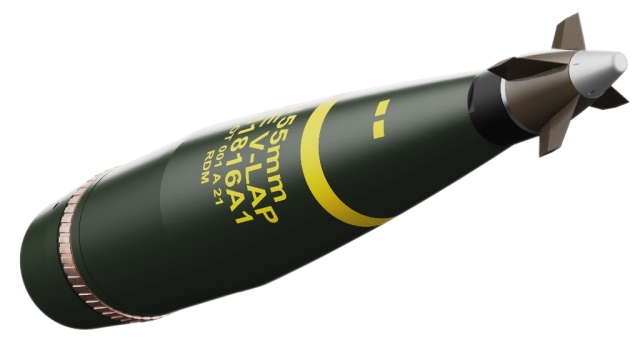As our blog has already reported, at the beginning of 2021, the German Rheinmetall AG group presented a proposal to create a 155-mm long-range highly automated self-propelled howitzer made on the chassis of a heavy military truck RMMV HX3 with a 10x10 wheel formula. The howitzer is being developed in variants with a swinging part with a barrel length of 52 and a promising 60 caliber, together with a family of new artillery ammunition, and should become one of the most advanced and long-range Western artillery systems. The publication "European Defense Review" (EDR) published the material by Paolo Valpolini "Indirect fires: Rheinmetall details its latest solutions" ("Fire from closed positions: Rheinmetall details its latest solutions") with a summary of some materials submitted by the Rheinmetall Group in December 2022 on this program. From this publication, in particular, it follows that this Rheinmetall ACS project is actually a joint (common) with the 155-mm/52 SIGMA self-propelled howitzer created by the Israeli company Elbit Systems (Israeli military designation Roem - "Swarm").
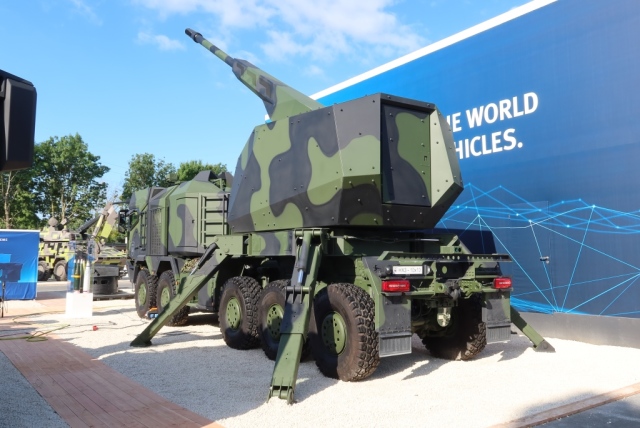
A demonstration sample of a promising long-range 155-mm highly automated self-propelled howitzer created by the German Rheinmetall group on the chassis of a heavy military truck RMMV HX3 with a 10x10 wheel formula at the Eurosatory 2022 exhibition. Le Bourget (Paris), June 2022 (c) www.edrmagazine.eu At the Eurosatory 2022 exhibition in June 2022, Rheinmetall Group presented its proposal for the German Zukünftiges System Indirektes Feuer mittlerer Reichweite (Advanced Medium-range closed-position Fire System), which aims to provide the German army with new long-range self-propelled howitzers on a wheeled chassis to counter Russian superiority in terms of firing from closed positions [hospody!].
A comparison of ranges immediately shows the critical situation in which Western armies found themselves in terms of barrel artillery: the Russian 2C35 "Coalition-SV" system reaches a range of more than 70 km, and the PzH 2000, currently one of the most advanced Western systems equipped with a 155-mm 52-caliber barrel, can shoot at a range of slightly more than 30 km, using ammunition with a narrowed bottom part, and less than 40 km, using a projectile with a bottom gas generator. Russia's attack on Ukraine on February 24, 2022 and the protracted war that followed showed once again that fire from closed positions causes 70-80% of the total losses. Many armies, including the German one, which had previously considered the possibility of improving their artillery means to eliminate this imbalance, accelerated their programs, and the industry is actively offering new solutions.
Rheinmetall's roadmap in this area is clear and aims to increase the firing range using new guns, new shells and new charges. Striking capabilities, range, survivability, mobility, ammunition, rate of fire, automation and ergonomics - all these areas need improvement to provide troops with effective systems, while reasonable growth potential is also a priority, given the need for subsequent improvements of new systems to adapt them to new threats and operational scenarios. In addition to the firing system (guns/howitzers), Rheinmetall is also working on gunpowder and projectiles to increase range and efficiency. During the 20th Rheinmetall Defense Talks Conference, held in Berlin on December 5-7, 2022, EDR was given a full briefing on what the Dusseldorf-based Rheinmetall Group is developing in the field of artillery,
Artillery on automobile chassis, a step-by-step approach with great growth potentialAdopting a pragmatic approach, Rheinmetall decided not to develop a completely new product and teamed up with the Israeli company Elbit Systems, since the latter already had a new artillery system at an advanced stage of development.
In April 2019, the Israeli Ministry of Defense signed a contract with Elbit Systems to develop a "promising artillery system to replace existing ones." Known as SIGMA ["Roem"], it is a fully automated howitzer mounted on an automobile chassis. SIGMA pre-production systems should be delivered soon, and the requirements of the Israel Defense Forces are more than 100 guns.
"Rheinmetall is Europeanizing it by integrating the swinging part of the RWM 155 mm/52, a fire control computer and installing the system on the HX3 10×10 RMMV truck - the demonstrator is expected to be pumped out in 2023," the vice president for business development of the Rheinmetall division told the audience at a conference in Berlin. Vehicle Systems Patrick Lenz. As expected, the new system will be fully automated, so the tower will be uninhabited, and a crew of two people will perform firing tasks while remaining in the protected cabin of the car. The tower has an automatic loader that works at any elevation angle of the barrel, a manipulator that feeds and sends shells and charges using a chain loader. It is compatible with all projectiles developed according to the standard of the Joint Ballistic Memorandum of NATO JBMOU (Joint Ballistics Memorandum of Understanding) and with charges conforming to the standards of the Modular Charge System (MCS) or Extended Range Charge (Extended Range Charge - ERC). The fuse installer provides programming of loaded ammunition using data provided by the fire control system. The installer is manufactured in accordance with the requirements of NATO AOP-22 (Allied Ordnance Publication) "Design criteria and test methods for the induction installation of electronic projectile fuses" and allows the installation of any fuses developed according to this standard.
The tower accommodates 40 shells and 192 charges in the stack, which will release 80% of the shells, that is, 32, with a full charge (six charges each). If it is required to fire at the same target, that is, without changing the elevation angle, the automatic loader provides a rate of fire of 8 rounds per minute. The turret mounted on a car chassis can fire up to five shots in the "Simultaneous fire raid" mode (Multiple Rounds Simultaneous Impact - MRSI). In case of failure of the automatic loading system, manual loading allows you to fire with half the rate of fire, and the calculation access is provided to the tower due to the corridor between laying shells on the left side and laying charges on the right side. On both sides we find two magazines, two for 20 shells on the left and two for 96 charges on the right; this provides redundancy, since each of them is equipped with its own electric motor, and in case of failure of one of them, the system will remain operational, although it will be able to perform a reduced number of firing tasks. The magazines are based on a continuous feed elevator of the Paternoster system and have a chain with 20 sections in which shells are placed, while the selected projectile moves to the manipulator, which grabs it and feeds it to the breech. Charge stores are conceptually similar, the required number of charging modules is loaded in accordance with the input data coming from the fire control system. This automatic charging system is currently undergoing qualification tests in Israel as part of the joint work of Elbit Systems with the Israel Defense Forces. The blowout panels ensure that any explosion will be directed outward, reducing the impact on the cab of the machine in which the calculation is located. If the customer needs more shots, additional 10-15 rounds of ammunition can be placed in the tower on additional racks, but, of course, not in the automatic loading system. The new system retains the PzH 2000 feed mechanism, which allows manually feeding ammunition from the outside, which is either used for immediate firing or loaded into magazines - this operation can be performed at a rate of 4 rounds per minute.
As it was said, the Rheinmetall version of the howitzer for installation on an automobile chassis will be equipped with a 155-mm / 52 mm swinging part. "It is similar to the one installed on the tracked self-propelled howitzer PzH 2000, but the cradle is different. Debugging firing will be carried out at the beginning of 2023, starting with firing from the stand and gradually reaching the firing tests of the complete system," said Patrick Lenz.
Rheinmetall installs an Artillery Turret Interface (ATI) between the turret and the chassis, equipped with four outriggers with hydraulic drive, which are the only hydraulic elements of the entire system. "They allow to stabilize the system so that it is possible to conduct circular fire at all 360 ° without any restrictions on the elevation angle and charges. The supports are extended in less than 20 seconds and removed in about the same time; in case of failure of the main system, the operation can be performed using the auxiliary power plant of the machine or, finally, it can be performed manually, of course, for a longer time," explained Patrick Lenz. As EDR understands, Rheinmetall is exploring the possibility of performing firing tasks without the need to extend the supports when firing at a limited angle of rotation of the gun - approximately ± 10 ° from the marching position "for 12 hours".
The platform is an HX3 10x10 chassis, the largest version of the new line of RMMV trucks. The turret is located at the rear, above the three rear axles, which ensures good load distribution, and the five-axle chassis provides good mobility, sufficient for the fire support system, which still does not need to directly follow the combat vehicles in the worst mobility conditions. "Two main reasons led to the choice of a truck rather than an armored personnel carrier as the preferred platform: one of them is the cost, the HX3 is about three times cheaper than the APC, and the second is the growth potential," said Patrick Lenz. Not only is the purchase price of the cargo chassis lower, but also the cost of its life cycle is less, which is all the more true if the army purchasing the system is already equipped with HX family machines. In the current configuration, the self-propelled howitzer has a weight reserve of an additional 5 tons, which provides flexibility in terms of building additional capabilities to cope with changing threats and scenarios.
One of the future developments has already been presented in Paris [at Erosatory 2022] in the form of a mock-up, the turret of which was equipped with a 60-caliber [155-mm] gun, which is currently being developed by Rheinmetall at its enterprise in Unterlus. The new gun has not only a longer barrel, but also a larger volume of the charging chamber, comparable to the American [155-mm / 58] ERCA (Extended Range Cannon Artillery) gun, and a completely redesigned muzzle brake. In addition to the L60 gun, the German group is also developing the L52A1 gun, which will provide higher pressure in the charging chamber - both of these solutions increase the firing range. At the same time, the loads on the tower will be very close, and the rate of fire will be the same as the current system.
New propellant charge to increase rangeHaving a long-barreled system for firing a projectile is not enough, the energy that the latter acquires when moving inside the barrel is provided by a propellant charge.
Improvements in this area are provided by Nitrochemie, a company jointly owned by Rheinmetall and RUAG and specializing in high-performance propellant powders. One of the key elements of the overall evolution towards longer firing distances is the Extended Range Charge (ERC).
"Its development started five years ago, and ERC has reached a relatively high level of maturity," said Pascal Schreier, senior vice president of sales and marketing of Nitrochemie propulsion systems at an event in Berlin. As EDR understands, the ERC charge is now offered for ammunition and platforms in service, so both can already be certified for ECR use. According to the information provided, ERC can increase the effective firing range of long-range ammunition (with a narrowed bottom part, and with a bottom gas generator) and new ammunition (reactive and V-LAP type) by 10-20%, increasing the initial velocity of the projectile and at the same time remaining within the permissible pressure in the barrel of existing guns, since it corresponds to the Permissible Maximum Pressure limit (PMP) of the system, established by the NATO standard STANAG 4110. This ensures a reduction in barrel wear and stability when firing. The ERC is supplied in one single cap, as it should provide maximum range, and its ballistic characteristics were confirmed in 2019-2022 on several systems and at different firing ranges, with two cycles of firing range tests in Alcantpan (South Africa), two in Yuma (USA), as well as shooting in Northern Europe.
"The increase in firing range can be used either to hit targets at long distances, or to compensate for the loss of range caused by the use of corrected fuses (CCF/PGK), which increase the accuracy of destruction by reducing the range by about 10%," Pascal said. Schreyer said, adding that "the new gunpowder technology was key in the development of ERC. Conventional gunpowder used in the available modular charges have an almost linear increase in velocity and pressure along with an increase in temperature."
ERC uses a new powder developed by Nitrochemie, known as P6, which is a three-part mixed powder obtained as a result of production without the use of solvents and with a treated surface. "The P6 allows you to achieve maximum performance at operating temperatures of about 21°C, thereby increasing the overall performance of the system in the most commonly used temperature range," said Pascal Schreyer. As an example, considering the PzH 2000, it is reported that at standard temperature, the pressure increases from about 330 to more than 380 MPa compared to the DM92 Zone 6 modular charge, and the initial velocity of the projectile increases by almost 70 m/s, from 945 to 1015 m/s. s., according to the presented schedule.
Two different versions of the ERC are currently available: one for 155 mm/39 caliber systems and the other for 155 mm/52 systems. Both have a design pressure of 395 MPa and can be used in the temperature range of -46 /+63 °C, however, their dimensions and weight differ: the length of the charge for the L39 gun is 780 mm with a weight of 13 kg, while the charge for the L52 systems has a length of 960 mm and a weight of 16 kg. The initial velocity of the projectile is obviously different: more than 900 m/ s for shorter barrels and more than 1010 m/s for longer ones. Until now, ERC's developments have been aimed at full-caliber ammunition, but Rheinmetall is ready to develop such a special charge for sub-caliber ammunition, if the customer needs it.
New projectiles to ensure optimal striking effect at long distances"Today we have a projectile with a narrowed bottom part [Boat Tail - BT], known as DM121 in Germany and M1712 in the Netherlands.
The latter can be transformed into the M1711, which has a bottom gas generator that allows you to reach a range of about 40 km when firing from a 155-mm/52 caliber PzH 2000 gun. Then we have the V-LAP projectile, a smart solution combining a bottom gas generator and a rocket engine, each of which is triggered at the required time. This solution allows you to have more explosives than a pure active-rocket projectile, but clearly less than a standard projectile," Dr. Christian von Hersten, head of the artillery and missile ammunition development department of the Rheinmetall Weapon & Munition business unit, told the audience, adding that V-LAP has demonstrated the ability to reach a range in numerous tests. 54 km using the DM92 modular charge system.
Moving from today's solutions to the possibilities of firing from closed positions in the near future, Rheinmetall presents this using an ERC charge, which, as mentioned earlier, allows you to increase the firing range by 10-20%. These characteristics were tested and confirmed back in 2019 using the PzH 2000 howitzer.
A medium-term solution is proposed with the L52A1 gun, which is an optimization of the currently available 155 mm/52 gun installed on the PzH 2000, and which can be qualified in a shorter time compared to a completely new gun. It uses the same barrel, the same shutter and the same obturation system as used now, however, it has a larger volume of the charging chamber and increased pressure in the charging chamber.
A long-term solution will obviously come with the L60 gun with a length of 60 calibers and new shells that are being developed within the framework of the aforementioned Zukünftiges System Indirektes Feuer mittlerer Reichweite program, the requirements for which provide for a firing range of 75 km with conventional ammunition. "Since this figure refers to unguided ammunition, we have added some range to compensate for CCF/PGK fuses," explains Dr. von Hersten. A range of 82 km will be achieved using the V-LAP projectile, which, as EDR understands, is a new development based on currently available projectiles, which will retain the same external dimensions and weight of 43.5 kg for compatibility with JMOU, but will be strengthened to be used with higher barrel pressure.
"The V-LAP carries about 4 kg of explosives, but we are working on a design with ready-made fragments that will increase the destructive power," he added. As part of its ammunition development program, Rheinmetall is also working on a new lead belt, which was tested in 2021 when firing PzH 2000 using modified charges. The charging system for the L60 will have a shortened sleeve to cope with the higher pressure in the charging chamber, and the igniter will be screwed into this shortened sleeve, and not located in the breech. The shot will ensure the achievement of an initial speed of 1144 m / s. It is expected that the first tests will take place in early 2023.
In addition to working on new shells and charges, Rheinmetall is also launching a program to modernize its SMArt 155 cluster shells (Suchzünder Munition für die Artillery 155Ammunition) with homing submunitions, which are currently in service in Germany, Greece, Switzerland and Australia, and are also certified for use in the United States.
Developed in the late 1980s by GIWS (Gesellschaft für Intelligente WirkSysteme, a joint venture between Rheinmetall and Diehl Defense), each such projectile contains two submunitions that are ejected over the target area, detect tanks and armored vehicles with their homing system, and hit them from above. This projectile was used in combat operations [in Ukraine] in 2022, so now it has a technological readiness level of TRL 9 [operating system, fully tested by operation]. To solve the obsolescence problems, GIWS has just started a modernization program; "In 2025 we will reach the component testing stage, production is scheduled to start in 2027," said Dr. von Hersten. However, the work will not be limited to replacing obsolete ammunition elements. "Here we are also striving to increase the firing range: currently, the projectile reaches a range of 22 km with the L39 barrel and 26 km with the L52 barrel. The program is implemented in partnership with General Dynamics Ordnance and Tactical Systems (GD OTS) in the USA. We have developed a new shell housing with a bottom gas generator, accommodating the same submunitions," he added. To test the range, in September 2021 and August 2022, shells with a bottom gas generator and inert equipment were fired; the first tests carried out from the L39 system reached a range of 27 km, and the following were carried out from the ERCA prototype with an L58 barrel, with a reduced charge and a lower elevation angle, reaching more than 38 km, the maximum predicted the range is 48 km with an initial speed of 1054 m/s. The new projectile is fully compatible with JBMOO, the program is implemented within the framework of the C-DAEM (Cannon-Delivered Area Effects Munition) project, GD OTS is the lead contractor. The projectile is also equipped with a new lightweight aerodynamically optimized ogival fairing, which reduces drag, enhancing the effect of the bottom gas generator. The decision of the American side is expected to proceed to the next stage of development.
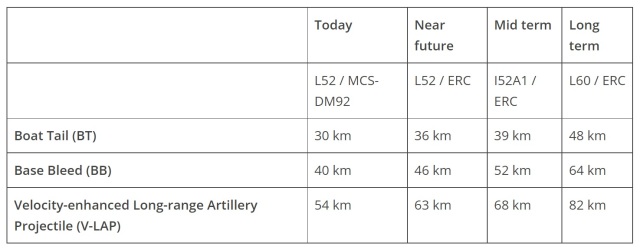
Ranges of firing from modern and promising 155-mm guns developed by Rheinmetall using long-range projectiles and charges of various types (c) Rheinmetall A demonstration sample of a promising long-range 155-mm highly automated self-propelled howitzer created by the German Rheinmetall group on the chassis of a heavy military truck RMMV HX3 with a 10x10 wheel formula at the Eurosatory 2022 exhibition. Le Bourget (Paris), June 2022 (c) www.edrmagazine.eu
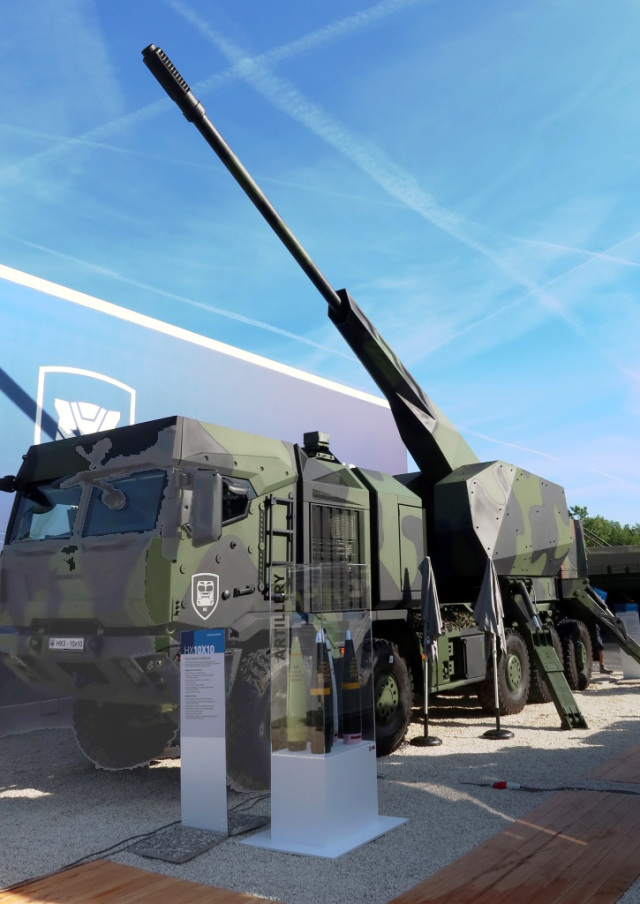
Graphic image of a promising long-range 155 mm highly automated self-propelled howitzer created by the German Rheinmetall group on the chassis of a heavy military truck RMMV HX3 with a wheel formula of 10x10 (c) Rheinmetall
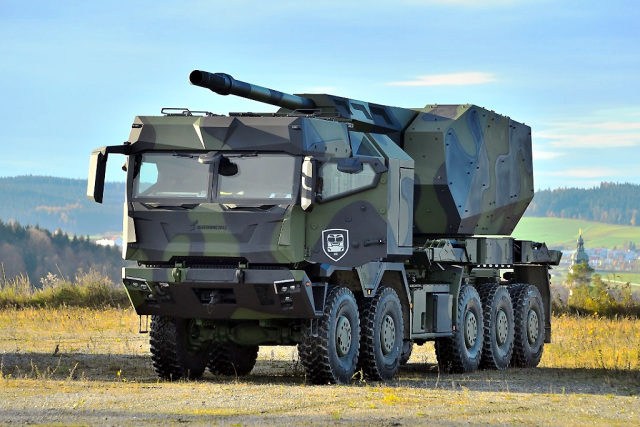
The device of an uninhabited tower created by the German Rheinmetall group of a promising long-range 155-mm highly automated self-propelled howitzer on a wheeled chassis, with a demonstration of the possibility of manual semi-automatic loading (it is characteristic that the same drawing is also distributed as an illustration for the 155-mm/52 SIGMA (Roem) self-propelled howitzer created by the Israeli company Elbit Systems) (c) Elbit Systems
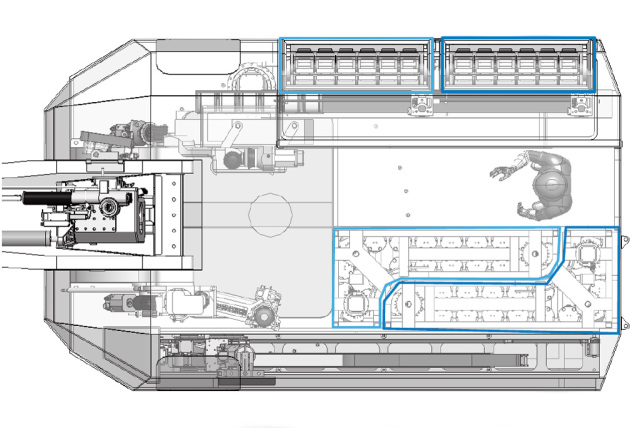
155-mm high-explosive projectile with a narrowed bottom part (Boat Tail - BT) DM121 manufactured by Rheinmetall Denel Munitions (c) Rheinmetall
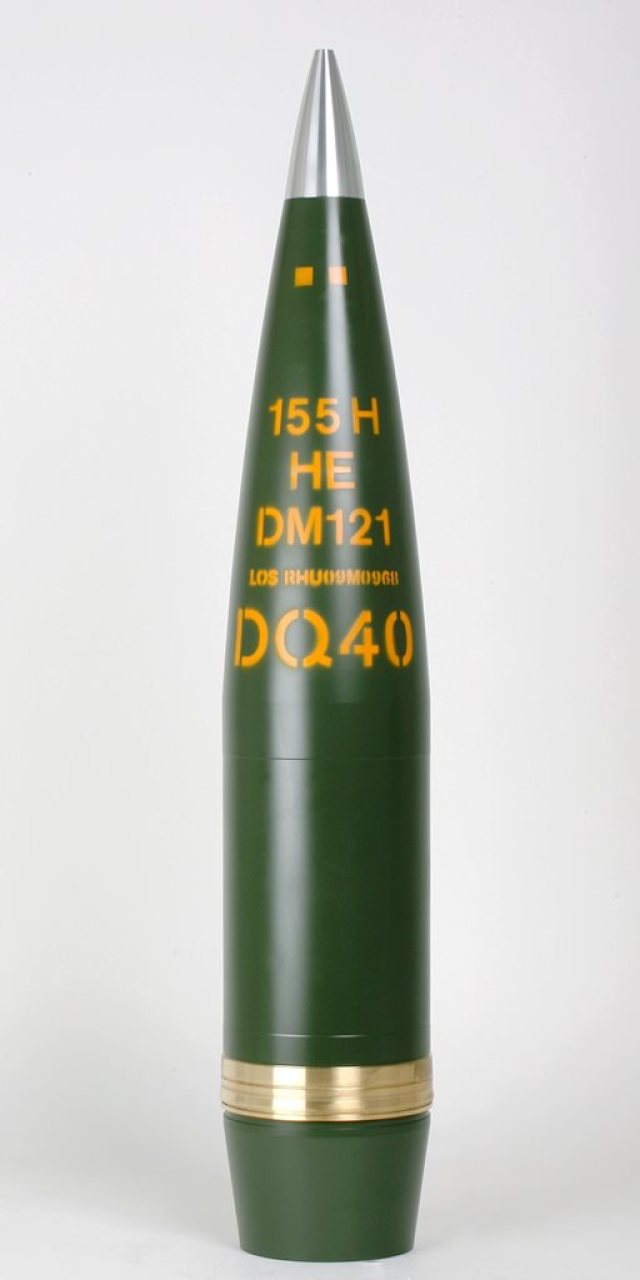
155-mm long-range projectile M1816A1 manufactured by Rheinmetall Denel Munitions type V-LAP (Velocity-enhanced Long-range Artillery Projectile) of improved aerodynamic shape with a bottom gas generator and rocket accelerator, additionally equipped with a fuse-correction device type CCF/PGK (c) Rheinmetall
